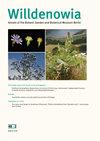Overall phylogenetic relationships of Scutellaria (Lamiaceae) shed light on the origin of the predominantly Caucasian and Irano-Turanian S. orientalis group
IF 1.4
3区 生物学
Q2 PLANT SCIENCES
引用次数: 4
Abstract
Abstract: Scutellaria is one of the largest genera in the Lamiaceae with an estimated 400–500 species with a nearly worldwide distribution. Most species occur in the N hemisphere, with the Caucasus and the wider Irano-Turanian region housing a large number of taxa, many of them considered endemic. We present an overall phylogeny of the monophyletic genus Scutellaria based on rapidly evolving plastid regions (matK-trnK, rpl16, trnL-F). Three well-supported clades are evident, which render the currently accepted S. subg. Scutellaria paraphyletic to S. subg. Apeltanthus, which appears nested in “clade A”, in which the African S. schweinfurthii is sister to all remaining taxa, followed by other lineages of S. subg. Scutellaria. Ancestral states of 12 morphological characters frequently used as diagnostic from subgenus to species level were reconstructed with BayesTraits. The S. orientalis group appears as a major radiation in the Caucasus area and the Irano-Turanian region that may comprise up to a quarter of the species in the genus. This radiation corresponds to a monophyletically defined S. sect. Lupulinaria, characterized by decussate inflorescences and specialized (e.g. cucullate) bracts. Our phylogenetic data present significant resolution at the species level within the S. orientalis group, indicating complex geographically centred patterns of speciation in adaptation to steppe and high mountain habitats, including multiple evolution of pinnate and tomentose leaves. The detailed infrageneric classification of Juzepczuk (1951, 1954) mostly does not reflect natural groups. Citation: Salimov R. A., Parolly G. & Borsch T. 2021: Overall phylogenetic relationships of Scutellaria (Lamiaceae) shed light on the origin of the predominantly Caucasian and Irano-Turanian S. orientalis group. – Willdenowia 51: 395–427. Version of record first published online on 23 December 2021 ahead of inclusion in December 2021 issue.黄芩科黄芩的系统发育关系揭示了以高加索和伊朗-图兰为主的黄芩类群的起源
摘要:黄芩属是Lamiaceae中最大的属之一,估计有400–500种,分布在世界各地。大多数物种出现在北半球,高加索地区和更广泛的伊朗-土兰地区有大量的分类群,其中许多被认为是特有的。基于快速进化的质体区域(matK-trnK,rpl16,trnL-F),我们提出了单系黄芩属的整体系统发育。三个支撑良好的分支是显而易见的,这使得目前被接受的S.subg。附系于S.subg的黄芩。Apeltanthus,似乎嵌套在“分支A”中,其中非洲S.schweinfurthii是所有剩余分类群的姐妹,其次是S.subg的其他谱系。黄芩。利用贝叶斯图像重建了从亚属到种的12个常用形态特征的祖先状态。东方S.orientalis群是高加索地区和Irano Turanian地区的主要辐射源,可能占该属物种的四分之一。这种辐射对应于单系定义的S.sect。羽扇豆属,特征为交叉花序和特化(如葫芦状)苞片。我们的系统发育数据在东方S.orientalis群的物种水平上具有显著的分辨率,表明在适应草原和高山栖息地时,物种形成的复杂的以地理为中心的模式,包括羽状和绒毛叶的多重进化。Juzepczuk(1951、1954)的详细亚属分类大多不能反映自然类群。引文:Salimov R.A.、Parolly G.和Borsch T.2021:黄芩(Lamiaceae)的总体系统发育关系揭示了以高加索和Irano Turanian S.orientalis群体为主的起源Willdenowia 51:395–427。该记录的版本于2021年12月23日首次在线发布,随后将收录在2021年12月刊中。
本文章由计算机程序翻译,如有差异,请以英文原文为准。
求助全文
约1分钟内获得全文
求助全文
来源期刊

Willdenowia
PLANT SCIENCES-
CiteScore
4.60
自引率
5.30%
发文量
17
审稿时长
>12 weeks
期刊介绍:
Willdenowia is an international peer-reviewed journal publishing original research articles in English from the entire fields of plant, algal and fungal systematics, covering the evolution, taxonomy and nomenclature of these organisms as well as related fields such as floristics and plant geography. Articles on phylogeny and molecular systematics are especially welcome, as are review articles. Descriptions of new taxa may be considered, but only if supported by robust evidence. Narrowly regional studies of widespread taxa, routine typifications, checklists and new floristic records are generally not considered (excluding contributions to the Euro+Med-Checklist Notulae). Authors are encouraged to deposit duplicates of their material, especially nomenclatural types, in the Berlin herbarium (B).
 求助内容:
求助内容: 应助结果提醒方式:
应助结果提醒方式:


